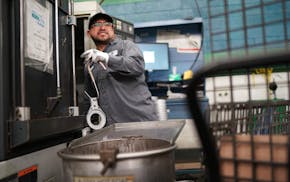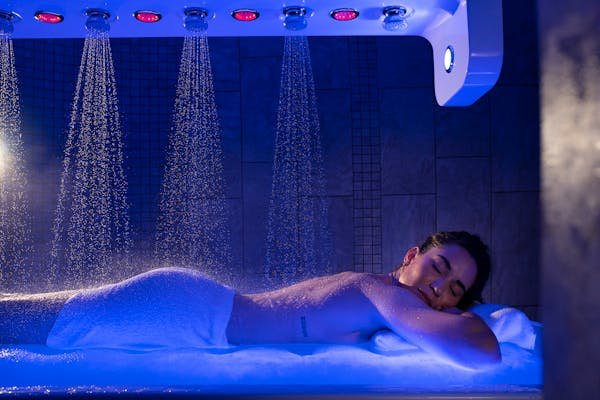Along France Avenue in Edina, med spas are almost as common as coffee shops, with nearly a dozen lining the street. Inside the Galleria, two — Lasérie and Lili Salon and Spa — sit beside one another.
There are many others in the Twin Cities, including in Wayzata and Highland Park in St. Paul.
The med spa industry is growing at 15% a year, fueled by social media influencers and more widely available medical-grade treatments, from laser treatments to Botox injections and IV infusions.
Sabyasachi Ghosh, associate vice president of Future Market Insights Inc., said the industry is "undergoing a transformative phase" driven by growing consumer acceptance of the minimally invasive procedures.
But medical professionals caution it's still a buyer-beware field. Across the country, lawsuits have been filed against med spas where patients were burned or received botched injections.
And Minnesota's regulation of the industry lacks clarity.
Katelyn Martinson, store manager of Face Foundrié Edina and a client at Lasérie , said clients, even those in their 20s, are looking for "anything to age gracefully" and that the treatments boost self-confidence.
"I'm on the side of 'do what you want.' With that being said, I think there is a line to be crossed when it comes to getting treatments," she said. "The beauty industry is growing rapidly every day with new products and services that can help with aging and appearance. All med spas need to have integrity when it comes to treating the skin and someone's face, focusing not on sales but truly improving someone's skin for the better."
Treatments not just for women
Nationally, there were about 1,600 med spas in 2010; there are more than 10,000 today, according to the American Med Spa Association (AmSpa).
The industry brought in $8 billion in 2024, and it's estimated it will bring in $27.7 billion in 2033, according to a report by Dimension Market Research.
The treatments aren't cheap, but they are cheaper than plastic surgery and the dermatological options available a generation ago.
While the medical cosmetic services were once seen as luxury procedures, more patients, including men, are showing interest. The spas call them "brotox" appointments.
But women still make up the majority of the market. Almost 90% of customers and 69% of med spa owners are women, according to industry data.
Lasérie, one of the Galleria's newest tenants, opened its doors in March. Michele Henry, its founder, said the location was a natural fit.
"What we found is we had a lot of clients asking where to get Botox and laser treatment," Henry said, referring to her previous venture, Face Foundrié, which still operates in the Galleria. "But we didn't have a partnership with any med spas that we could rightfully send them to."
Med spas average about 245 patient visits per month, according to AmSpa. With an average of $527 spent per visit, that translates to just under $130,000 in monthly revenue.
Even with inflation causing a slight dip — $9 less per visit compared to last year — industry insiders see steady, long-term growth.
"There was a bit of a market correction after the post-COVID rush," said Mike Meyer, AmSpa content manager. "But since then, it's been pretty stable."
The newer treatments allow steady improvement, said Haley Benjamin, owner of Lili Salon Spa. While the previous generation of treatments were dominated by noticeable enhancements, today's services offer clients more natural-looking results, with less downtime.
Lili is "proud to be a one-stop shop," Benjamin said. Besides med spa treatments, it operates a nail and hair salon and day spa.
Prices not always listed
Local med spa owners say price transparency is a key differentiator. Henry said she has seen operations where she felt clients were taken advantage of financially.
"When I would go in, nobody would tell me exactly what I was going to pay," she said. "That didn't sit right with me."
Lasérie and Lili both list their prices online. Lili requires a consultation if pricing for services could vary, such as Botox.
A session of Kybella — an injection of deoxycholic acid that dissolves fat under the chin — costs $1,200 at Lili. Botox, listed under "Tox and Dysport" on Lasérie's service menu, costs $12 per unit.
Catherine Gevers, store manager of Face Foundrié Maple Grove and a Lasérie client, said the price works for her. She goes once a month for the Moxi laser and Dysport injection, which totals around $600.
"Honestly, I think if enhancing or elevating your natural features boosts your confidence and makes you feel good, then absolutely go for it," she said. "It's a personal choice, and everyone's version of self-confidence looks different."
Martinson spends $85 per month for an AI-mixed serum from Lasérie. The AI skin analysis and robot that makes the serum is the first and only one inside an American med spa. Martinson said she also receives a Dysport injection to reduce wrinkles every four to six months, which costs about $150.
But the buyer-beware aspect kicks in on price, too, said Dr. Brian Zelickson, a board-certified dermatologist and director at Schweiger Dermatology Group in Edina.
"It's not always more expensive to go to a physician. A lot of times it can be less expensive, because you're doing a lot of treatments at a med spa that aren't that effective, that aren't covered by insurance," Zelickson said. "It adds up quite a bit."
Botox costs $14.25 per unit at Schweiger and, Zelickson argues, people might get more qualified professionals in a doctor's office.
Minnesota law 'murky' for industry
As the industry expands, regulation has struggled to keep pace.
David Holt, a health care attorney, said Minnesota's laws on med spa operations remain "murky." The state hasn't passed specific legislation to define what procedures non-physicians can perform.
"The conservative interpretation is that only doctors should do injectables and laser treatments," Holt said. "But the more liberal view is that estheticians or other non-physicians can do them."
That legal ambiguity leaves questions for clients.
For example, med spas must be supervised by a health care professional. But that person can be a nurse, physician assistant or nurse practitioner, Holt said. Medical directors also aren't required to work on-site.
They also are not required to be in a specialty related to the services, Zelickson said.
More than 70% of med spa medical directors nationwide come from non-core specialties, meaning they aren't plastic surgeons or dermatologists.
There aren't many pathways for legal resolution, Holt said, unless a malpractice lawyer takes it, but many won't. It then comes down to whether the attorney general has the time or interest to pursue it.
Earlier this year, Texas restructured its med spa regulations after a woman died from a botched IV infusion.
"Early on in my career, in the mid to late '90s, we went to the Legislature to tighten these laws up and got nowhere," Zelickson said. "Their thought was we were trying to restrict trade."
Holt said changes usually come in response to tragedy, not prevention.
Clients should ask questions
With so many med spas to choose from and few regulations, patients should do their homework, experts say.
"Choosing a med spa should come down to who has the best medical doctors," Holt said, "not who's best at marketing."
Patients also should verify who's performing the procedure; ask what their qualifications are; check whether the spa offers clear pricing; and understand consent protocols, Zelickson said. It's also important to know who the medical director is and how frequently they're on-site.
Both Lasérie and Lili Salon Spa are overseen by licensed medical professionals with their own practices: Devon Ellena, co-founder of Ellena Aesthetics and a nurse practitioner, at Lasérie, and Dr. Sue-Mi Tuttle, a board-certified plastic surgeon and owner of Tuttle Plastic Surgery, at Lili.
"You want to find a place that has a team with experience and spends the time listening to your goals," said Benjamin, owner of Lili. "It's about trust, education and feeling confident in the care of the professional."
"Oftentimes, aesthetic medicine is misunderstood in a sense that since it's elective, it must be inherently vain. I try to look at things from a more holistic perspective," said Tanner Gifford, a registered nurse and lead injector at Lasérie. "When we address concerns around skin or facial structures and their modulation, we are often addressing our perception of self. And that is a deeply personal thing."

DOGE cuts federal money for upgrades at Velveeta plant in New Ulm

Minnesota factories see orders tank on continued trade uncertainty
'We don't want to lose this mine': Fear sets in for Iron Range miners as shutdown takes hold

UnitedHealth sues the Guardian, alleging defamation in coverage of nursing home care

